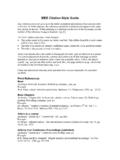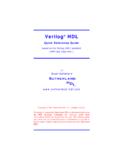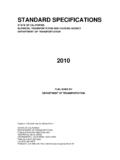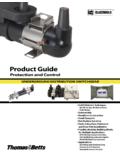Transcription of Volume 1: Syntax and Style - IVI Foundation
1 Standard Commands for programmable instruments (SCPI). Volume 1: Syntax and Style VERSION May, 1999. Printed in 1999 SCPI Syntax & Style NOTICE, STATEMENT of INTENT. and AUTHORIZATION TO COPY. Copyright 1999 SCPI Consortium This document defines the Standard-Commands-for- programmable -Instr uments (SCPI) Consortium's SCPI. standard. Although the Consortium hereby expressly disclaims any and all warranties whatsoever regarding the SCPI standard, the Consortium has published this document with the intent that the SCPI standard will be seriously considered and adopted, in whole, by the test and measurement marketplace. Consistent with that intent, permission is hereby granted by the Consortium to make copies of this entire document as a whole, PROVIDED THAT this NOTICE, STATEMENT of INTENT and AUTHORIZATION TO COPY shall prominently appear on each such whole copy. Further consistent with that intent, permission is hereby granted by the consortium to make copies of portions of this document, absent this NOTICE, STATEMENT of INTENT and AUTHORIZATION TO COPY, PROVIDED THAT each such portion-copies shall only be used in a manner which is consistent with the purposes of implementing, promoting, disseminating, or enhancing (as opposed to deviating from) the SCPI standard as herein defined, such as the inclusion of such a portion-copy in an instrument (or instrument-related) product manual which implements SCPI (as defined herein) or in use for design of such an instrument (or instrument related) product.
2 However, under no circumstances may copies of this document, or any portion of this document, be made solely for purposes of sale of the copy or copies. For information, contact: European SCPI Consortium Contact: Fred Bode, Executive Director John Pieper SCPI Consortium ACEA. 2515 Camino del Rio South, Suite 340 Box 134. San Diego, CA 92108 7640 AC Wierden The Netherlands Phone: (619) 297-1210 Phone: +31 546 57 79 94. Fax: (619) 297-5955 Fax: +31 546 57 55 75. Email: Email: Web Page: Web Page: i 1999 SCPI Syntax & Style Foreword Commercial computer-controlled test instruments introduced in the 1960s used a wide variety of non-standard, proprietary interfaces and communication protocols. In 1975, the Institute of Electrical and Electronic Engineers approved IEEE 488-1975. IEEE 488 defined a standard electrical and mechanical interface for connectors and cables. It also defined handshaking, addressing, and general protocol for transmitting individual bytes of data to and from instruments and computers.
3 This standard has been updated and is now IEEE Although it solved the problem of how to send bytes of data between instruments and computers, IEEE 488. did not specify the data bytes' meanings. Instrument manufacturers freely invented new commands as they developed new instruments . The format of data returned from instruments varied as well. By the early 1980s, work began on additional standards to specify how to interpret data sent via IEEE 488. In 1987, the IEEE released IEEE , Codes, Formats, Protocols and Common Commands for Use with IEEE This standard defined the roles of instruments and controllers in a measurement system and a structured scheme for communication. In particular, IEEE described how to send commands to instruments and how to send responses to controllers. It defined some frequently used housekeeping commands explicitly, but each instrument manufacturer was left with the task of naming any other types of command and defining their effect. IEEE specified how certain types of features should be implemented if they were included in an instrument.
4 It generally did not specify which features or commands should be implemented for a particular instrument. Thus, it was possible that two similar instruments could each conform to IEEE , yet they could have an entirely different command set. Standard Commands for programmable instruments (SCPI) is the new instrument command language for controlling instruments that goes beyond IEEE to address a wide variety of instrument functions in a standard manner. SCPI promotes consistency, from the remote programming standpoint, between instruments of the same class and between instruments with the same functional capability. For a given measurement function such as frequency or voltage, SCPI defines the specific command set that is available for that function. Thus, two oscilloscopes made by different manufacturers could be used to make frequency measurements in the same way. It is also possible for a SCPI counter to make a frequency measurement using the same commands as an oscilloscope.
5 SCPI commands are easy to learn, self-explanatory and account for both novice and expert programmer's usage. Once familiar with the organization and structure of SCPI, considerable efficiency gains can be achieved during control program development, independent of the control program language selected. ii Table of Contents Chapter 1 Introduction Requirements .. 1-1. Organization .. 1-1. SCPI Goals .. 1-1. SCPI Usage .. 1-2. Instrument Interchangeability .. 1-3. Chapter 2 References Chapter 3 Life Cycle Adding a Capability .. 3-1. Obsoleting a Capability .. 3-1. Device Dependent Commands .. 3-2. Chapter 4 SCPI Compliance Criteria IEEE Requirements .. 4-1. IEEE Mandated Commands .. 4-1. IEEE Optional Common Commands .. 4-1. IEEE Common command Implications .. 4-1. Overlapped and Sequential Commands .. 4-2. *CLS .. 4-2. *OPC and *WAI .. 4-3. *OPC? .. 4-3. *RST .. 4-4. Interaction With the Synchronization Commands .. 4-4. Implications For *SAV and *RCL .. 4-4. *RST and *RCL as Overlapped Commands.
6 4-4. *IDN? .. 4-5. SCPI Requirements .. 4-5. Required Commands .. 4-5. Optional Commands .. 4-6. Documentation Requirements .. 4-6. Chapter 5 Notation Interpreting command Tables .. 5-1. Interpreting Syntax Flow Diagrams .. 5-2. v 1999 SCPI Syntax & Style Chapter 6 Program Headers Common command and Query Headers .. 6-1. Instrument-Control Headers .. 6-1. Mnemonic Generation Rules .. 6-1. Building the command Tree .. 6-2. Queries .. 6-6. Traversal of the Header Tree .. 6-7. Multiple Capabilities and Numeric Keyword Suffixes .. 6-8. Single Instrument with Many Electrical Ports .. 6-8. Multiple Identical Capabilities .. 6-8. Logical instruments .. 6-9. Chapter 7 Parameters Character Program Data .. 7-1. Decimal Numeric Program Data .. 7-1. <numeric_value> Definition .. 7-1. DEFault .. 7-1. MINimum|MAXimum .. 7-2. UP/DOWN .. 7-2. STEP Subsystem command Syntax .. 7-3. [:INCR ement] <numeric_value> .. 7-3. :PDECade <numeric_value> .. 7-3. :MODE LINear|LOGarithmic|L125|L13 .. 7-3. :AUTO <Boolean>|ONCE.
7 7-4. STEP Subsystem Examples .. 7-4. INFinity and Negative INFinity (NINF) .. 7-4. Not A Number (NAN) .. 7-4. Unit Suffixes .. 7-5. Boolean Program Data .. 7-5. Coupling of Functions .. 7-5. Functional Coupling .. 7-6. Value Coupling .. 7-6. Automatic Coupling .. 7-7. Units of Measure and Suffixes .. 7-7. Units of Amplitude and Power .. 7-7. Expressing Unitless Quantities .. 7-9. Chapter 8 Expressions Function .. 8-1. Usage .. 8-1. Syntax .. 8-1. Numeric Expression .. 8-2. Syntax .. 8-2. vi 1999 SCPI Syntax & Style Precedence Rules .. 8-3. Semantics .. 8-3. Channel Lists .. 8-3. Numeric Lists .. 8-6. Chapter 9 Status Reporting The Device-Dependent Register Model .. 9-3. Transition Filters .. 9-3. Operation Status Register .. 9-3. QUES tionable Data/Signal Status Register .. 9-4. Multiple Logical instruments .. 9-5. Status Structure for the Expanded Capability Trigger Model .. 9-7. Chapter 10 *RST Conditions Chapter 11 Naming Conventions :DEFine <name>,<data> .. 11-2. :DEFine?
8 <name> .. 11-2. :DELete[:NAME] <name> .. 11-2. :DELete:ALL .. 11-2. :CATalog? .. 11-2. Chapter A Programming Tips vii 1999 SCPI Syntax & Style 1 Introduction Requirements This Volume , Syntax and Style , is global in nature and shall be used with all other volumes of the SCPI standard. 1. Organization 2. The first five chapters of Syntax and Style are an introduction to the overall concept of SCPI 3. 1999. They describe an overview of the standard, reference other standards , describe SCPI. compliance criteria, and how to interpret command tables and Syntax flow diagrams. The 4. next three chapters in this Volume describe the program headers, parameters and expressions 5. from which SCPI commands and responses are built. Following this are chapters which describe the status reporting model, Style guidelines for creating new commands, the effect 6. of *RST on parameter values, and facilities for managing named sets of data in an 7. instrument. 8 Bode This Volume , Syntax and Style , is the first of the four- Volume set that makes up the SCPI.
9 1999 Standard. The second and largest Volume is the SCPI command Reference, which 9. contains the actual language constructs which appear in instruments . The third Volume , Data 10. Interchange Format, defines a standard representation for data sets which may be used between instruments and applications, between applications, or directly between 11. instruments . The fourth Volume , Instrument Classes, defines the SCPI commands and 12. behavior needed to implement functionality sets associated with common classes of instruments . These four volumes form the complete 1999 SCPI Standard and should be used 13. as a set. 14 Bode This document is intended to apply to systems instruments . It defines both organization 15. and content of messages at the controller-to-instrument and instrument-to-controller information interchange level. This document was developed so that, an instrument 16. designed in accordance with it, shall be able to conform to IEEE Std. Standard 17. Digital Interface for programmable Instrumentation, and IEEE Std.
10 Codes, Formats and Common Commands For Use With IEEE Std. Conformance to 18. IEEE and IEEE is not required by this document, recognizing that 19. some instruments implement physical interfaces other than the IEEE However, SCPI is based upon the concepts and terminology used within these standards . 20. This document may impact the related person-to-instrument and the instrument-to-person 21. information interchange levels. Though the main purpose of this document is to define the 22. interface as it relates to remote control, implementation of these codes and formats may affect the front panel of the instrument involved. 23. 24. SCPI Goals The goal of Standard Commands for programmable instruments (SCPI) is to reduce 25. Automatic Test Equipment (ATE) program development time. SCPI accomplishes this goal 26. by providing a consistent programming environment for instrument control and data usage. This consistent programming environment is achieved by the use of defined program Introduction 1-1.









